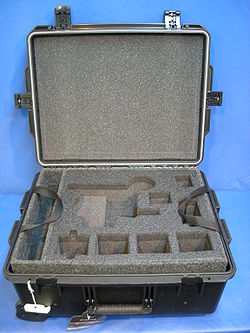
Transit case
Encyclopedia

The difference between a transit case and a suit case is a transit case is configured with internal foam or other structure to hold and protect specific items. A suit case is an empty case in which items can be placed in any order with no predefined locations other than features such as internal pockets. An empty transit case can be used as a suit case.
Transit cases can be procured in virtually any size to contain something very small to very large which may require several people or a fork lift to move.
Road case
Road case
A road case, commonly referred to as a roadie case, is a shipping container specifically built to protect musical instruments, motion picture equipment, audio and lighting production equipment, properties, or other sensitive equipment when it must be moved between locations, or frequently thrown...
s are a subset of transit cases. Road cases are traditionally manufactured with plywood sides and metal corner braces. Transit cases are usually molded or formed from plastic, composite materials or aluminum so the top and bottom sections are seamless.
A rack case is a transit case with provision for mounting rackmount equipment such as amplifiers, computers, displays, radios, encryption devices, and so forth. In many cases, the internal 19-inch rack is mounted to the transit case via shock absorbing mounts giving the rack sway space to attenuate shocks and bumps that might be seen during shipment and handling.
Features
A wide variety of features and options are available for transit cases. The minimum feature set would include:- Rugged construction to protect the contents from mechanical abuse
- Tailored internal cushioningCushioningPackage cushioning is used to help protect fragile items during shipment. It is common for a transport package to be dropped, kicked, and impacted: These events may produce potentially damaging shocks. Transportation vibration from conveyors, trucks, railroads, or aircraft can also damage some...
, blocking, and bracing. - Environmental sealing to protect against moisture, humidity, rain, dust, insects, chemicals, etc.
- Multiple draw-down latches to firmly secure the cover(s) on all sides.
Other available features may include the following:
- Hinged or lift-off lid
- Two removable end caps
- Pre-cut foam, custom factory-cut foam, or do-it-yourself foam
- Rackmount rails for installation of 19-inch rackmount equipment
- Shock mounts for an internal rackmount frame
- Retractable handles which are protected in some regard during shipping
- Airtight seal when the lid is closed and latched down
- Atmospheric pressure equalization valve
- Nitrogen filler valve
- Humidity indicators
- Wheels or casters
- Wheels and an extensible handle similar to a pull-around suitcase
- Legs to allow the removed lid to be used as a desk
- Environmental controls: Air conditioners, heaters or fans
Construction
The principle design of a transit case is to assure environmental sealing and protection for the contents in adverse circumstances. Thus, construction techniques that provide seamless components (body, lid, end caps) are primarily used.- Rotomolded and thermoformed polyethylenePolyethylenePolyethylene or polythene is the most widely used plastic, with an annual production of approximately 80 million metric tons...
- Rotomolded LLDPE thermoplastic
- Deep drawn aluminum
- FiberglassFiberglassGlass fiber is a material consisting of numerous extremely fine fibers of glass.Glassmakers throughout history have experimented with glass fibers, but mass manufacture of glass fiber was only made possible with the invention of finer machine tooling...
reinforced thermoset composites - FRP composite (fiberglass reinforced polyester)
- Carbon fiber composite
- Carbon fiber / Kevlar composites
- Laminated materials (mostly used on road casesRoad caseA road case, commonly referred to as a roadie case, is a shipping container specifically built to protect musical instruments, motion picture equipment, audio and lighting production equipment, properties, or other sensitive equipment when it must be moved between locations, or frequently thrown...
)
Standards
- ATA 300Ata 300ATA Spec 300 is an airline transport specification that establishes requirements for the design, development and procurement of effective packaging for supplies and equipment shipped by airlines....
for airline transportation survivability - MIL-HDBK-304C - Package Cushioning Design
- MIL-P-116 - Preservation methods
- MIL-STD-130MIL STD 130MIL STD 130 is a standard that is mandated by the DoD for any item to be UID compliant. MIL-STD-130 permits printing or marking the UID symbol with most of the conventional technologies used to produce a name plate or a label and this standard can be easily incorporated with any existing source or...
- Marking or printing identification data - MIL-STD-648D - Design Criteria Standard Specialized Shipping Containers
- MIL-STD-810F - Environmental test methods and engineering guidelines
- MIL-STD-1367A - Packaging, Handling Storage and Transportability Program Requirements for Systems and Equipment
- MIL-STD-1472 - Human Engineering
- MIL-STD-2073-1D - Standard Practice for Military Packaging
- MIL-T-4734 - Transit Cases, Combination Cases and Spare Parts Cases for Ground Electronic Equipment
- Fed Test Method Std 101 - Test procedures for packaging materials

